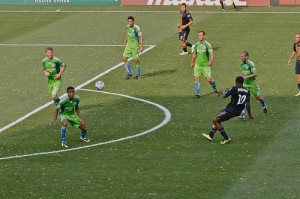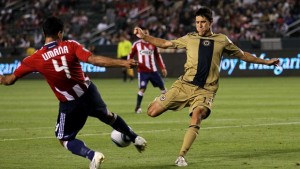Nearly halfway through the MLS season, Philadelphia Union manager Peter Nowak is still tinkering.
Nowak has deployed 10 different lineups in 12 regular season games. All three lines – defenders, midfielders, forwards – have changed. He only repeated lineups after the Union’s first two wins and then tweaked them again after they failed to produce consecutive victories. Only left back Jordan Harvey and goalkeeper Chris Seitz have started every match at the same position.
The changes seem maddening at first glance. Why is Michael Orozco playing midfield against Chivas USA? Why did Danny Mwanga ever play center midfield? What’s Shea Salinas doing at right back right after that brilliant attacking game against Houston? Why does last week’s attack-minded 4-1-3-2 look more like a 4-3-1-2 this week without any wingers?
Some tactical changes were driven by simple necessity. But others seem potentially fascinating.
For a necessity example, take the Seattle game on June 27. Center back Orozco’s suspension prompted Nowak to slide benched right back Cristian Arrieta over to Orozco’s spot against Seattle, with backup center backs Shavar Thomas and Toni Stahl remaining in exile. Danny Mwanga’s terrific finishing forced his way into the lineup at forward, with Sebastien Le Toux dropping back to right midfield. That shifted Fred to his natural center midfield position and (along with injury, perhaps) kicked midfielder Kyle Nakazawa to the bench.
But then why, a game later against Chivas, is Orozco playing midfield?
On paper, it looks like a simple substitution of Orozco for injured forward Alejandro Moreno, with Le Toux sliding to forward. But isn’t it more logical to move Orozco to center back, Arrieta to right back, and Salinas to right midfield, positions they’ve played for years?
This is where it gets interesting, and it starts with Salinas.
Since day one, Salinas has seemed the most fascinating Union player to watch. He has roadrunner legs on a human body and goes from zero to 60 as fast as some cars. When Nowak finally started him at winger against Houston, Salinas produced a goal that might end up as MLS Goal of the Year. (Click here, and go to the 59-second mark. Shorter clips don’t show enough.) But a half game later, he was at right back after Arrieta’s form dipped.
It first seemed counterintuitive. Now it’s beginning to look inspired.
Look at Salinas. What’s his ceiling? Right now, he’s a good MLS winger and could be a great one given a full season starting at right midfield.
But put him at right back, and you may have the fastest right back in MLS. He’s dangerous off the dribble and can free himself up to send crosses. Defensively, he was quick enough to erase Patrick Nyarko and Steve Zakuani, two of the league’s speediest wingers. Pair him with a steady stay-at-home left back like Harvey, and you balance an asymmetrical attack that can be similar to what Maicon does for Brazil.
It’s almost as if Nowak isn’t satisfied with just being good at a position. He’s aiming for brilliance, willing to jettison players’ past positions to determine, from scratch, where they belong at the highest level of the game.
Because of it, Salinas could jump into a wide open pool of right backs hoping to start for the U.S. National Team in 2014 after Steve Cherundolo’s eventual retirement from international play.
That seems to be the method to Nowak’s madness: A pursuit of greatness at the expense of goodness. He and top assistant John Hackworth built their team with youth, and they haven’t let the fluctuations of an actual season get in the way of the long-term goal. You often hear that sentiment from new franchises, but rarely do you actually see in-game experimentation like this to prove it.
Some experiments won’t work. Fred isn’t a winger. At age 30, he’s not changing. Mwanga looked lost as a center attacking midfielder but brilliant as a striker in the box. Maybe Stahl, a defensive midfielder pre-MLS, will return to play center back again, but we haven’t seen him since his opening day red card. Elsewhere, San Jose played Bobby Convey everywhere but left midfield last year with predictably poor results, and now back at his natural position, he’s performing well.
In the end, this year’s Union team is just the start, with post-World Cup transfer activity to be expected. The experiments have surely helped show Nowak which pieces can be great instead of just good and tell him where to focus attention in the transfer market. Salinas may prove just one successful experiment. We may find that Orozco, with his excellent composure on the ball but standing just 5-9, was miscast as a center back and is truly a defensive midfield destroyer of international caliber.
Maybe we’ll get more than just a good team in Philadelphia Union. Maybe, just maybe, we’ll get brilliance.
What do you think about all the tactical maneuvering? Am I nuts here? Is this a total Captain Obvious moment? Would you rather I just wrote a standard post-game review and not taken July 4 off? Or is Nowak nuts, and does he just need to stop screwing around and start putting guys in the positions they’ve excelled at before? Weigh in below.
(Thumbnail photo: Daniel Gajdamowicz)





Well, I certainly hope that’s the case. And Nowak has never seemed dumb to me, so he must have some method behind his maneuvering. I’m excited for the second half of the season.